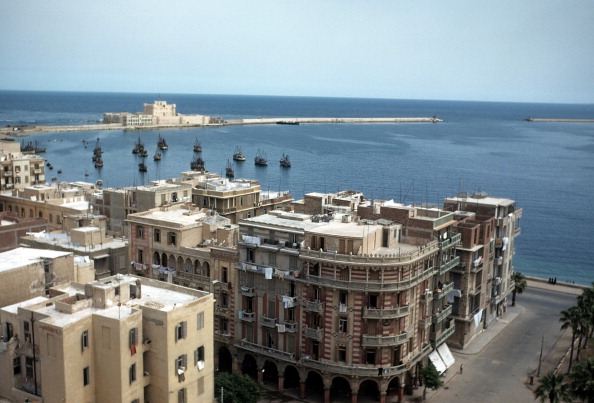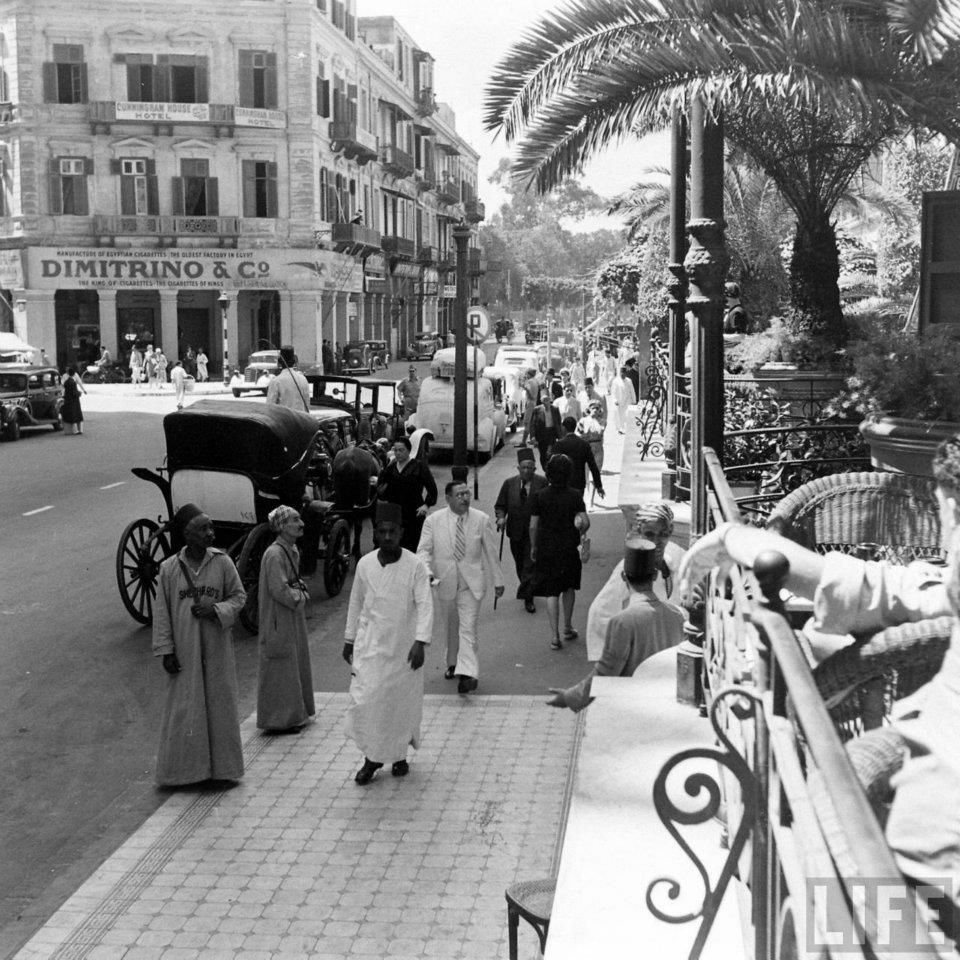It is an early spring morning in Alexandria's waterfront Ramla Square and a distinguished-looking man—neither local nor fully foreign in his appearance—sits at one of the tables of Délices, a fabled patisserie facing the historic Cecil Hotel that was a hangout for Alexandria's beau-monde in the city's cosmopolitan years. The man orders in native, Egyptian-accented Arabic, glances at the newspaper's front page, then pulls out a cell phone and exchanges a few sentences in Greek with an unseen interlocutor.
The incident would have been entirely unremarkable in the decades when multicultural Alexandria pulsed to a melting-pot beat largely shaped by its Greek community. But the foreign residents departed in the aftermath of the 1956 Suez Crisis and nationalizations ordered by socialist Egyptian President Gamal Abdel Nasser. The most recent turmoil—started in 2011 and still ongoing—stripped the city's public spaces of their remaining foreign element: tourists. Now, spotting a foreigner, much more a Greek, elicits the kind of thrill more often associated with encountering a pride of lions while on safari.
A WRITER IN EXILE
The mystery man turns out to be George Kypraios, a novelist and former resident of a city that no longer exists. Alexandria's urban structures are mostly still standing, but its boulevards, belle époque buildings, churches and synagogues have long been closed. Alexandria: End of an Era (2010) is Kypraios's Greek-language paean to the city he grew up in which now exists only in the memories of those who whiled away their childhood in its streets when it was still an extraordinary ethnic mélange. His book, like the equally fascinating Voices From Cosmopolitan Alexandria (2012), is an effort to commit fleeting memories of the city to paper.
Ιn the 1990s, Kypraios would split his time equally between Alexandria, Athens, and his wife's native France. But the post-revolutionary turbulence only compounded the city's demographic and social decline. According to municipal figures, 27,000 new buildings went up in just the past three years, the majority illegal brick high-rises often erected in the spaces formerly occupied by historic apartment blocks and villas. Old, unprofitable buildings were gutted at night by men employed by underground construction mafias, even though some were on protected monument lists. Harassed by aggressive neighbors and disturbed by the disconcerting pace of change, Kypraios now spends barely two months a year in Alexandria.
When he does visit, he seldom leaves his high-ceilinged belle-époque apartment off the once-chic Rue Fouad and limits his excursions to coffee at the Délices and dinner at the lesser-known of the city's two Greek clubs: not the expensive restaurant commanding a stunning view of the curving bay favored by the city's Egyptian neo-elites and tourists, but the gloomy hall in the Greek Quadrangle area whose jealously-guarded door is opened only for members of Alexandria's dwindling Greek community. Inside, mezze and bottles of whisky decorate every table and regulars nod at each other, or—as befits an ossified minority where decades-long vendettas fester in a cabin-fever environment—studiously ignore the other's presence.
LAST ENCLAVES, LINGERING VILLAS
Clubs such as the Greek and the Sporting are some of the last enclaves of the Levantine society that once dominated the city's public life. Today they are inhabited by septuagenarian remnants of that time, reminiscing over how things once were, while watching playing grandchildren and attendant daughters. When they get up to leave, their frail forms are swallowed by the city's swirling traffic and the towering high-rises that multiply with each passing year. Their cars drive past the occasional Rococo villa sheltering in the shadow of the apartment blocks. With the land those buildings occupy worth its weight in gold, they are unlikely to witness much more of the twenty-first century. Earlier this month, the Villa Aghion—a 1920s modernist gem built by Auguste Perret, an architect with UNESCO World Heritage Site awards to his name—was removed from the list of historical buildings and demolished.
"Fewer and fewer of the villas remain," said an old member of the Greek community who remained in Alexandria after the majority of his relatives left. "Even if one's own villa is not wrecked, just being overshadowed by high buildings strips away any kind of privacy or pleasure in continuing to live in it."
In the narrow streets of bustling Attarine, once known as the Foreigners' District, Italians would rub shoulders with Greeks, Jews, Armenians and Tsarist exiles. Today, the neighborhood is famous for its antique shops selling off mementoes of the past. Sometimes, that same past carefully displayed on shop fronts or piled up in dark interiors spills over into the present, such as in the lanes rendered impassable by piles of old wooden doors, carved windows, mashrabiya lattices and balcony railings, all looted from Alexandria's collapsing apartments.

SHIRAX AND THE SPITFIRE BAR
I am searching for the small, aluminum cigarette boxes etched with exotic scenes of waifish Oriental women surrounding the Sphinx from 1940s Egypt and stamped with the names of long-defunct Greek tobacco manufacturers. At an antique shop named Shiraz, the attendant calls the owner to inform him he has customers. A middle-aged man resembling a plumper version of the Alexandrian poet Constantine Cavafy walks through the door of his shop and benignly sizes me up from behind round spectacles.
Joseph Sednaoui is descended from a renowned Syrian family that emigrated to Alexandria in the late nineteenth century. He stayed behind when most of the minorities and shuwwam (Levantine Arab immigrants to Alexandria) left because "I had my routines, my friends and my hangouts to which I still go. What reason is there to leave?"
One of Sednaoui's favorite watering holes is the historic Spitfire Bar. An Alexandrian institution tucked away on the ground floor of a building fronting onto a small square, the small bar's rooms are illuminated by red fluorescent lights, festooned in English and Scottish flags and filled with the sounds of 1980s pop and disco. It was opened by a Greek in 1883 and is still a center for the city's intellectuals and dropouts. Rumors that the bar is about to become another one of modernizing Alexandria's casualties are only half true: Ali, the owner, is looking to sell, but his asking price of 2.5 million Egyptian pounds (approximately 360,000 US dollars) renders the prospect of a purchase optimistic at best.
That's just as well, because the kind of Egyptian who frequents the Spitfire—a place that veritably exudes alcohol fumes—is a breed at risk of extinction. While less daring intellectuals squeeze into the Cafe De La Paix alongside cohorts of hairgelled/headscarved couples, the Spitfire's tables are frequented by long-haired, bespectacled artists leading European foreign-language teachers and employees of the city's cultural centers through the waters of an unfamiliar culture.
MANSHEYA AND A FLAT FROZEN IN TIME
A few minutes' walk from the Spitfire through crowded street-markets brings me to Mansheya, once Alexandria's most exclusive central square, and still surrounded by the imposing buildings once inhabited by powerful Western consulates, the first Bourse in the Middle East, and several high-powered businesses such as the Magasins Hannaux department store.
Tonight, like most nights, the area is flooded by a tidal wave of humanity sweeping across its mud-spattered memory of a park, pausing to examine the clothes on sale from street vendors, and sidestepping glue-sniffing kids sunk in torpid reveries. Yesteryear's socially stratified crowds divided themselves into Europeans-by-birth, Europeans-by-protection (the shuwwam community who often purchased the privileges afforded by a European passport), and the indigenous Muslim, Christian and Jewish communities as they marched up and down that same square in a bourgeois spectacle.
Past stalled traffic and street hawkers competing with each other, a jump into the entrails of a once-magnificent commercial complex offers a glimpse into the past. Shops, cafes and a babel of commotion burst from its peeling, scarred galleries and arcades. A staircase winds up to a high-ceilinged apartment currently under renovation.

These were the offices of Behna Films, once the Arab world's largest movie production company and distributor. Gudran, the youth collective currently renovating the apartment, point out that Egypt was the location of only the second-ever film screening in history, during a visit by the Lumière Brothers, whose proto-cameras needed strong light sources in order to register moving images.
The impossibly high-ceilinged apartment with its intact library and period cinema cameras resembled a time capsule when it was first reopened. Now it's being revitalized to act as a cultural center and workshop for filmmakers, photographers and researchers in visual art. Once completed, Behna Film's archive of scripts, old camera reels and equipment will remain as polished memories of a glorious past. At a time when local construction companies such as Stanly Group are demolishing waystations in Alexandria's visual history such as Egypt's first modern cinema, the Rialto, and replacing them with malls and luxury hotels, Gudran are saving one of the forgotten shards of the city's past while demonstrating another way of repurposing Alexandria's empty old buildings.
CITY OF MEMORIES
Back at the Délices Café, Kypraios is describing what it was like to grow up in a city that once personified Gilded Age frivolity. The son of a Greek Leftist, he didn't participate in the giddy social scene. His father schemed with Greek novelist and leftist Stratis Tsirkas and others over how to resist the English presence in Egypt, led a sailors' revolt for greater workers' rights during the Second World War, and went into self-imposed exile first to Moscow and then Tashkent, where he died unmemorialized behind the Iron Curtain in the 1960s. Kypraios was left with memories and an unbreakable bond to Alexandria.
Today, he appears to inhabit a city of memories frozen sometime in the mid-1950s. When referring to the club where Tsirkas and his father would meet, and which became the title of the first book in Tsirkas' acclaimed Drifting Cities trilogy—still considered a more realistic rendering of wartime Alexandria than Lawrence Durrell's colonial-accented Alexandria Quartet—he casually waves a hand down the street as if the leftist comrades were just about to break from a secret meeting for coffee. And when he refers to the street on which his apartment is on, it is by its old Greek name, even though that name was replaced by an Egyptian one over half a century ago. Perhaps in a twenty-first century Alexandria gripped by rapid change, inhabiting melancholy shadows is preferable to encountering reality.
"Alexandria was always my Ithaca," said Kypraios, alluding to Cavafy's most famous poem. "I wrote [my book] because speech is lost but writing remains.”
*Iason Athanasiadis is a writer, photographer and documentary film producer based between Istanbul and Tripoli, Libya. He studied Arabic and Middle Eastern Studies at Oxford University, and Persian and Contemporary Iranian Studies at Tehran's School of International Studies.






